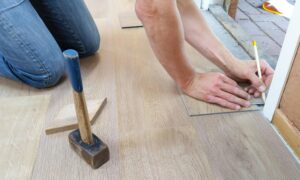
How to Tackle DIY Home Projects and Save Money
If you want to upgrade your living space without spending a fortune, DIY home projects are the way to go. Not only do you save money, but you also get the satisfaction of adding personal touches to your home. Whether you’re a seasoned DIY enthusiast or a beginner, here are some practical tips and project ideas to help you save money while improving your home.
Read also: How to Save on Entertainment
1. Plan Your Projects
Assess Your Needs
Start by taking a good look around your home and identifying areas that need attention. Prioritize projects based on necessity and budget. Focus on high-impact areas like kitchens, bathrooms, and curb appeal, as these can increase your home’s value the most.
Set a Budget
Determine how much you’re willing to spend on each project. DIY projects can save money, but costs can still add up. Include all necessary materials, tools, and any unexpected expenses in your budget.
Do Your Research
Once you’ve identified your projects and set a budget, research how to do them. Use online resources like YouTube tutorials, blogs, and DIY forums for step-by-step guides. Educating yourself beforehand will make the process smoother and help you avoid costly mistakes.
2. Essential Tools and Supplies
Invest in Basic Tools
A well-stocked toolbox is essential for any DIY project. Basic tools you’ll need include a hammer, screwdrivers (both flathead and Phillips), a tape measure, a level, pliers, wrenches, and a utility knife. Power tools like a drill, a circular saw, and a sander can also be incredibly useful and save you a lot of time.
Buy Quality Supplies
Don’t skimp on quality when it comes to supplies. High-quality materials ensure your projects last longer and look better. Look for sales, use coupons, and consider buying in bulk for better prices.
Safety Gear
Always prioritize safety. Goggles, gloves, ear protection, and masks are essential for protecting yourself while working on home improvement projects.

3. Easy DIY Projects for Beginners
Paint a Room
Painting is one of the easiest and most cost-effective ways to transform a space. Choose a color that complements your existing decor, and make sure to prep the room properly by cleaning the walls and using painter’s tape to protect trim and ceilings. Invest in good-quality paint and brushes for a professional finish.
Install a Backsplash
Adding a backsplash in your kitchen or bathroom can dramatically change the look of the room. Peel-and-stick tiles are an excellent option for beginners—they’re easy to apply and can be cut to fit any space. Measure your area accurately and take your time to align the tiles properly.
Update Cabinet Hardware
Swapping out old cabinet hardware for new knobs and pulls is a quick and inexpensive way to update your kitchen or bathroom. Simply remove the old hardware, fill in any holes if necessary, and attach the new pieces. This small change can make a big difference in the overall look of your space.
Create a Gallery Wall
A gallery wall can add personality and style to any room. Gather frames in various sizes and styles, and fill them with photos, artwork, or prints that you love. Lay out your arrangement on the floor before hanging to find the perfect layout. Use picture-hanging strips to make the process easier and avoid damaging your walls.
4. Intermediate DIY Projects
Install Floating Shelves
Floating shelves are a stylish and practical addition to any room. They provide extra storage and display space without taking up floor space. Use a stud finder to locate wall studs for secure installation, and ensure your shelves are level. You can find ready-to-install shelves at most home improvement stores.
Build a Raised Garden Bed
If you have a green thumb, building a raised garden bed is a great way to grow your own vegetables and flowers. Use untreated wood to construct the frame, and fill it with a mixture of soil and compost. Raised beds offer better drainage and can make gardening easier on your back.
Replace Light Fixtures
Upgrading your light fixtures can modernize your home and improve lighting. Turn off the power at the breaker box before starting, and follow the fixture’s installation instructions carefully. If you’re unsure about electrical work, consult a professional.
Refinish Furniture
Refinishing old furniture can give it new life and save you money on buying new pieces. Sand down the existing finish, apply a primer if needed, and then paint or stain the furniture to your liking. This is a great way to customize your furniture to match your decor.
5. Advanced DIY Projects
Install Laminate Flooring
Replacing old carpet or linoleum with laminate flooring can make a huge difference in your home’s appearance. Laminate is durable, easy to clean, and relatively simple to install with a click-and-lock system. Measure your space carefully, allow the flooring to acclimate to your home’s temperature, and follow installation instructions closely.
Build a Deck
Building a deck is a more ambitious project, but it can significantly increase your home’s value and provide a great outdoor space. Plan your design, get the necessary permits, and follow local building codes. Use pressure-treated wood or composite decking for durability.
Remodel a Bathroom
A bathroom remodel can range from simple updates like replacing fixtures to a complete overhaul. Consider retiling the shower, installing a new vanity, and updating lighting. Be sure to waterproof areas prone to moisture and consider hiring a professional for plumbing and electrical work if you’re not experienced in those areas.

6. Money-Saving Tips for DIY Projects
Reuse and Repurpose
Look for ways to reuse and repurpose materials you already have. Old furniture can be transformed, leftover paint can be used for smaller projects, and reclaimed wood can add character to new builds. Being creative with what you have can save money and add unique touches to your home.
Shop Sales and Clearance
Keep an eye out for sales and clearance items at your local home improvement store. End-of-season sales can offer great deals on outdoor furniture, gardening supplies, and more. Online marketplaces and discount stores can also have affordable options for materials and tools.
DIY with Friends
Team up with friends or family members for your DIY projects. Not only can you share tools and supplies, but you can also help each other with larger tasks. Plus, it’s more fun and rewarding to work together on home improvements.
Take Advantage of Free Resources
Many home improvement stores offer free workshops and classes on various DIY topics. Take advantage of these opportunities to learn new skills and get hands-on experience. Online resources like YouTube and DIY blogs also provide valuable tutorials and tips.
Conclusion
Taking on DIY home projects is a fantastic way to save money, personalize your space, and gain new skills. By planning ahead, investing in the right tools, and starting with manageable projects, you can successfully tackle home improvements yourself. Remember to prioritize safety, do thorough research, and enjoy the process of making your home truly your own.






